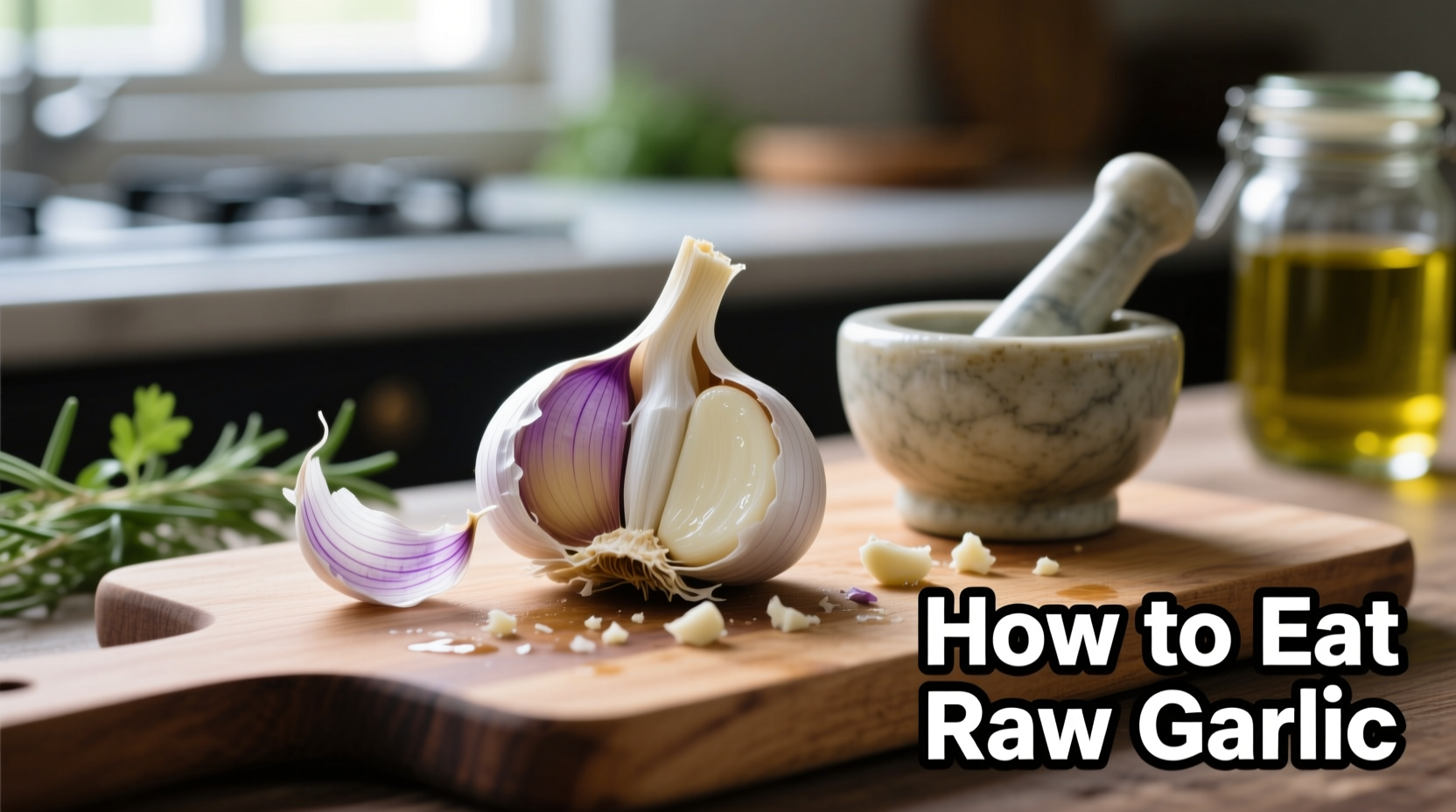Consuming raw garlic properly maximizes its health benefits while minimizing side effects. The optimal method involves crushing or chopping fresh garlic cloves and letting them rest for 10 minutes before consumption to activate allicin, garlic's key bioactive compound. Limit intake to 1-2 cloves daily, preferably with food to reduce digestive discomfort. This guide provides science-backed techniques for safely incorporating raw garlic into your diet while preserving its potent medicinal properties.
Why Raw Garlic Matters: The Science Behind Maximum Benefits
Raw garlic contains significantly higher levels of allicin—the compound responsible for most of garlic's health benefits—compared to cooked garlic. When garlic cells are damaged through crushing or chopping, the enzyme alliinase converts alliin into allicin. This reaction requires time and is destroyed by heat above 60°C (140°F).
| Preparation Method | Allicin Preservation | Key Benefits Maintained |
|---|---|---|
| Raw, crushed & rested 10 min | 100% (peak) | Antimicrobial, cardiovascular, immune support |
| Raw, consumed immediately | ~60% | Partial antimicrobial benefits |
| Cooked before crushing | 0% | Flavor only, no medicinal properties |
| Cooked after resting 10 min | ~40% | Some cardiovascular benefits |
According to research published in the Journal of Agricultural and Food Chemistry, allowing crushed garlic to rest for 10 minutes before cooking preserves up to 90% of its beneficial compounds compared to immediate cooking. This simple timing adjustment makes a significant difference in therapeutic value.
Step-by-Step Guide to Consuming Raw Garlic Safely
Proper Preparation Technique
- Peel fresh cloves - Select firm, plump garlic with tight skin
- Crush or chop finely - Use a knife or press to break cell walls
- Let rest 10 minutes - Critical for maximum allicin formation
- Consume with food - Mix with honey, olive oil, or in dressings
This preparation method, validated by the National Center for Complementary and Integrative Health, ensures you receive garlic's full medicinal potential. The 10-minute resting period allows complete conversion of alliin to allicin—the compound responsible for garlic's antimicrobial and cardiovascular benefits.
Daily Intake Guidelines
For most adults, 1-2 cloves of raw garlic per day provides optimal benefits without adverse effects. The European Medicines Agency recommends not exceeding 5 grams (approximately 1 clove) of fresh garlic daily for therapeutic purposes. Excessive consumption can cause:
- Digestive upset and heartburn
- Increased bleeding risk (especially before surgery)
- Bad breath and body odor
Practical Ways to Incorporate Raw Garlic Into Your Diet
Simple Consumption Methods
The Honey Method: Mix 1 crushed clove with 1 teaspoon raw honey. The honey coats the stomach lining, reducing irritation while preserving benefits. This combination has been shown in NIH research to enhance garlic's antimicrobial properties.
Garlic-Infused Olive Oil: Combine crushed garlic with extra virgin olive oil and let sit for 10 minutes. Use immediately in dressings or as a finishing oil. Avoid storing garlic in oil at room temperature due to botulism risk.
Delicious Raw Garlic Recipes
Immunity-Boosting Dressing:
- 1 crushed garlic clove (rested 10 min)
- 2 tbsp extra virgin olive oil
- 1 tbsp lemon juice
- 1 tsp raw honey
- Pinch of sea salt
Whisk ingredients together and use immediately on salads or roasted vegetables. This dressing preserves garlic's medicinal properties while making consumption pleasant.

Managing Common Side Effects
Reducing Garlic Breath
Garlic breath results from allicin metabolites entering your bloodstream. To minimize this:
- Eat fresh parsley, mint, or apples after consumption
- Drink lemon water or green tea
- Consume milk (especially whole milk) with garlic
A 2016 study in the Journal of Food Science found that consuming raw or heated apples and lettuce reduced garlic breath compounds by up to 50% when eaten simultaneously with garlic.
Digestive Comfort Tips
For those with sensitive stomachs:
- Always consume raw garlic with food, never on empty stomach
- Start with 1/4 clove daily and gradually increase
- Pair with healthy fats like avocado or olive oil
- Avoid raw garlic if you have GERD or ulcers
Who Should Avoid Raw Garlic
Raw garlic consumption isn't appropriate for everyone. The following groups should exercise caution or avoid raw garlic entirely:
- Individuals taking blood thinners (warfarin, aspirin)
- Those with upcoming surgical procedures (stop 2 weeks prior)
- People with irritable bowel syndrome or acid reflux
- Individuals with garlic allergies (rare but possible)
The Mayo Clinic advises consulting your healthcare provider before adding therapeutic amounts of raw garlic to your diet if you have any chronic health conditions or take prescription medications, as garlic can interact with numerous pharmaceuticals.
When Raw Garlic Isn't Appropriate
While raw garlic offers maximum health benefits, there are specific contexts where cooked garlic may be preferable:
- For children under 5 - Raw garlic can be too harsh for developing digestive systems
- During pregnancy - Consult your healthcare provider; moderation is key
- When taking certain medications - Including HIV medications and blood thinners
- For extended therapeutic use - Long-term high consumption may affect gut microbiome balance
Remember that garlic supplements don't provide the same benefits as fresh garlic. The National Institutes of Health states that aged garlic extract and other supplements contain different compounds than fresh, raw garlic and shouldn't be considered equivalent substitutes for achieving the same health benefits.











 浙公网安备
33010002000092号
浙公网安备
33010002000092号 浙B2-20120091-4
浙B2-20120091-4